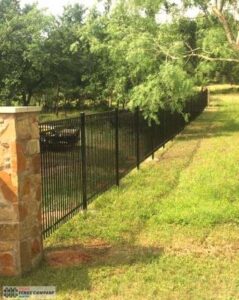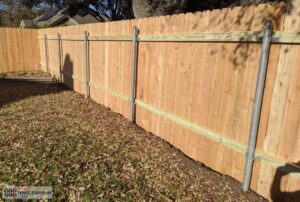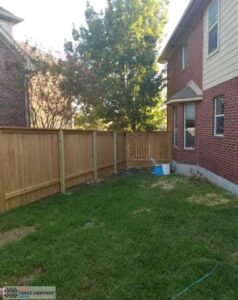Pool Barrier Checklist Austin for Homes
TL;DR
In Austin, a pool barrier for residential pools must be at least 48” tall, limit openings to < 4”, have self-closing, self-latching gates that swing out, and meet anti-climb rules to help protect young children. Atlas Fence Company can design/install barriers that pass inspection without sacrificing style—black ornamental steel, vertical cedar, glass, or removable black mesh—when detailed correctly. If a powered/locking ASTM F1346 safety cover is used, the code may permit it as an alternative to a fence; however, most owners still opt for a physical barrier for daily safety. Use the checklist below and have a professional verify the latch height, gaps, and hardware.
Table of Contents
ToggleWhy this checklist matters in Austin
Austin uses a modern pool-safety framework, and inspectors will verify barrier details at the final. Homeowners often pass on the second try because of small misses: a latch mounted an inch too low, a 4¼” gap at a step, or a gate that closes—but not latches—from a soft push. This checklist turns those “gotchas” into easy wins and pairs them with the construction details we see work best locally. Regular inspections are conducted to prevent accidents, protect your family, and make pool safety a top priority for homeowners in Austin. If you’re still choosing a style, our companion guide covers compliant looks and layout options: Pool-Safe Fence Design in Austin (Style + Code).
Quick pre-inspection scan (2 minutes)

Before you dive into the detailed list, do this walk-around:
- Measure barrier height at the lowest adjacent grade—confirm ≥ 48” all the way around.
- Try a 4” test (tennis ball ≈ 2.7”, so use a marked template or tape measure): no opening should pass a 4” sphere.
- Check the bottom gap around: tight to grade over lawn/rock, slightly larger allowed over hardscape, but still under the limit.
- Open each pedestrian gate: it should swing out (away from the pool), self-close, and self-latch from a gentle 4–6” release. Gates should be equipped with compliant hardware to prevent access by children.
- Look within 3 ft outside the fence line: remove benches, planters, A/C pads, or step-stones that create climb-ups.
This walk-around helps identify visible issues that could allow children to access the pool area and assists pool owners in maintaining compliance with regulations.
If you clear those in two minutes, you’re likely in great shape—now confirm the details below.
The Pool Barrier Checklist (printable)
Use these items exactly as you’d run through them on site.
Pool and Spa Safety Barrier Checklist
- This checklist applies to both pools and spas, including hot tubs, and is designed to help ensure compliance with all relevant safety standards.
- Printable documents and forms are available for download to assist with inspections and recordkeeping.
Barriers and Fencing
- All barriers must be constructed to prevent unauthorized access by young children.
- Openings in the barrier, including those formed by lattice fences or diagonal members, must not exceed a maximum opening of 4 inches. The maximum opening formed by any part of the barrier, including lattice fence and diagonal members, must not exceed 1¾ inches.
- For chain link fences, the maximum mesh size must not exceed 1¼ inches square, unless slats are fastened to the fence to reduce the openings.
- Solid barriers, such as masonry or stone walls, must not contain indentations or protrusions that could facilitate climbing.
- The distance between horizontal members must be less than 45 inches if horizontal members are accessible from the outside. The spacing of vertical members must not exceed 4 inches. Horizontal members should be placed on the pool side of the barrier to prevent climbing.
- The maximum vertical clearance between the bottom of the barrier and the ground or pool structure must not exceed 2 inches for non-solid surfaces and 4 inches for solid surfaces.
- Pedestrian access gates must open outward, away from the pool or spa area, be self-closing, and be equipped with a self-latching device. The release mechanism for the locking device must be located at least 54 inches above the ground or on the pool side of the gate, inaccessible to children.
- All gates must have a locking device and a latching device to prevent unauthorized access.
Additional Safety Measures
- Pool covers that meet safety standards can be used as an additional barrier to prevent children from accessing the pool or spa area.
- Audible alarms must be installed on doors and windows that provide direct access to the pool or spa area. These alarms should meet sound level and activation timing standards to alert adults immediately upon unauthorized entry.
By following this checklist, you can help ensure that your pool or spa area is as safe as possible for children and meets all local safety regulations.
Heights & openings

- Barrier top is ≥ 48” above adjacent grade everywhere (walk the whole perimeter; measure where grade dips).
- No hole or opening anywhere in the barrier admits a 4” sphere (including between pickets, under gates, at stepped grades, and beneath decorative gaps). No opening greater than 4 inches is allowed at any point in the barrier.
- For chain link fences, the maximum mesh size must not exceed 1¼ inches square unless slats are fastened at the bottom to reduce the openings.
- For lattice fence or barriers with diagonal members, the maximum opening formed by these elements must not exceed 1¾ inches. Ensure that the maximum opening and the maximum opening formed by any part of the barrier, including lattice fence and diagonal members, comply with these limits to prevent child access.
- Bottom clearance: tight to grade on soil/gravel; allowable slightly larger on hardscape, but still below the inspection limit.
- If the barrier steps with a slope, overlaps/returns prevent openings >4” between panels.
Unclimbable exterior
- If the fence has horizontal and vertical members, the exterior (yard side) must not create a ladder effect. The distance between horizontal members should be less than 45 inches, and horizontal members should be placed on the pool side to prevent climbing.
- When horizontal rails are close together, ensure they’re on the pool side and vertical gaps are tightened to the small spacing requirement. The distance between vertical members should not exceed 4 inches.
- All slats must be fastened securely to reduce openings and prevent children from climbing or passing through.
- When rails are far apart, keep vertical spacing at or under the 4” rule.
- No decorative cutouts, large perforations, or footholds that create rungs on the exterior face.
- Use solid barriers such as masonry or stone walls without openings, indentations, or protrusions. Solid barriers should not have features that could facilitate climbing.
- In Austin, choose flat-top metal profiles (no spear-tops/spikes).
Gates
- Pedestrian access gates: All pedestrian access gates must open outward, away from the pool area, and be equipped with a locking device and a self-latching device. The release mechanism for the gate should be located at the required height to prevent young children from accessing the pool area.
- Swing direction: Every pedestrian gate opens away from the water (outward).
- Self-closing: From a soft 4–6” release, the gate closes fully without assistance.
- Self-latching: The latch catches reliably after self-closing; test 5–10 times.
- Hinge alignment: Hinge barrels are in a straight line; no binding or dragging.
- Bottom gap at gate: Confirm it remains below the allowed limit across the threshold.
Latch placement
- Standard approach: Latch is ≥ 54” above finished grade, measured at the outside of the gate. The release mechanism must be located at a height that is inaccessible to young children to prevent unauthorized access.
- Alternate pool-side latch: If the latch is only reachable on the pool side, it sits just below the gate top, and all holes/openings near the latch are reduced to the small, child-resistant sizes specified within the defined radius. The release mechanism should also be located so that children cannot easily reach it.
Hardware & fasteners
- Hinges and latches are corrosion-resistant, exterior-grade, through-bolted, or properly lagged.
- Any locking device must be installed appropriately to ensure secure pool access control.
- All slats must be fastened securely to prevent openings that could allow unauthorized entry.
- No sharp points or projecting fasteners that could snag or injure.
- Any self-closing hinge has adjustable tension; set to close without slamming.
Where the barrier meets structures
- If the house wall forms a side of the barrier, each door or operable window giving pool or spa access must have compliant audible alarms (or equivalent protection) per listing. Audible alarms should meet standards for sound level and activation timing to alert adults immediately upon unauthorized entry.
- The maximum vertical clearance between the bottom of the barrier and the ground or pool/spa structure must not exceed 4 inches to prevent children from crawling underneath.
- Pool covers or safety covers that meet recognized safety standards can be used as an alternative safety measure for pools and spas, providing an effective barrier against unauthorized access.
- Any equipment (pumps, heaters) or permanent objects outside the barrier are ≥ 36” away so they don’t become steps.
Bottom line for mini-mesh or screen systems
- Removable mesh safety fences have tensioned panels, reinforced borders, latching sections, and respected setbacks from the water’s edge per listing.
- For safety, the maximum mesh size for mesh fences should not exceed 1¼ inches square unless additional slats are used to reduce openings. Any slats used must be fastened securely to prevent gaps that could allow a child to pass through.
- Anchors are set straight and capped when removed.
Slopes, steps, and retainers
- At retaining walls or grade breaks, the barrier must be located to prevent access at grade changes, and the maximum vertical clearance between the bottom of the barrier and the ground or pool structure must be maintained. The barrier continues without creating a climbable route.
- Step pads, low seating, or raised planters near the fence are pushed back or lowered outside the 3-ft clear zone.
Pro tip: Run the checklist before scheduling your city final—minor fixes (raising a latch, adding a return, tightening a picket gap) take minutes and prevent re-inspection delays.
Gate, latch & hardware specifics (what actually passes)
- Self-closing hinges: Set tension so the gate closes from a gentle 4–6” start and still latches. Avoid over-tension that warps posts.
- Latches: Magnetic or concealed gravity latches are standard. Gates must be equipped with a locking device and a self-latching device, and the release mechanism should be installed at the required height to prevent young children from accessing it. Mount per the rule set you’re using (54” high or pool-side protected configuration).
- Strike alignment: After final grade, reset the strike plate so it latches without slamming.
- Thresholds: Where lawn meets hardscape, add a small paver pad under the latch swing path to keep the bottom gap consistent.
- For pro installation and adjustments, see Gate Installation — Austin.
When the house is part of the barrier
Using the house side reduces fence footage but adds device requirements:
- Doors/operable windows leading to the pool or spa area need audible alarms (audible, distinct) on all openings, or an approved alternate such as compliant pool covers or spa covers that meet safety standards.
- Verify alarm placement, volume, and power source; test each opening during your pre-inspection walk to ensure the audible alarm activates properly.
- If you’d rather avoid alarms on patio doors, many owners choose a stand-alone fence line with returns to the house only at non-door sections.
Materials & style notes that still pass

- Black ornamental steel (flat-top): Great sightlines, inherently unclimbable with correct picket spacing, and durable.
- Vertical cedar privacy: Easiest path to the 4” opening requirement; orient rails to keep the exterior unclimbable.
- Frameless/low-profile glass: Premium look; ensure edges and gate gaps remain under limits.
- Removable black mesh: Kid-friendly, HOA-friendly in many neighborhoods, and inspection-friendly when installed per listing.
- Horizontal looks: Use a vertical exterior screen or detailing that removes footholds on the yard side while keeping the modern vibe.
- Lattice fence, chain link fences, and solid barriers: These materials are also options for pool and spa barriers if they meet safety requirements. Lattice fences should have openings no larger than 1¾ inches. Chain link fences must have mesh openings no greater than 1¼ inches, unless slats are used. Solid barriers, such as masonry or stone walls, should not have climbable features.
Need help choosing? We can pair code compliance with the look you want: Fence Installation — Austin.
Austin-specific field tips
- Expansive clay: Clay swells/shrinks seasonally. Use solid post foundations (gravel base + crowned collar for wood; full-depth concrete or core-drill for steel/glass). Seasonal movement can shift latches—plan for periodic tweaks.
- Limestone shelves: West Austin sites often need core-drilling and epoxy or non-shrink grout for posts; don’t skimp on embedment.
- Sun & heat: Dark metal gets hot; place child latches where small hands won’t linger on sun-baked surfaces.
- Irrigation: Redirect heads away from gate lines and bottom rails; standing water reduces bottom clearance and swells wood.
- Visible leaks & plumbing: When inspecting the pool barrier area, check for any visible leaks around the pool surface, equipment, and plumbing. Inspect plumbing lines and connections for signs of wear or damage to ensure proper operation and prevent costly repairs.
- “Safe fencing” profiles: Flat tops and knuckled chain-link selvage reduce injury risks and ease approvals.
FAQs
Most backyard fences aren’t individually permitted, but pool barriers are inspected at final. Build the checklist and plan a pre-inspection walk.
Listed safety covers can be part of a compliant strategy, but many families still prefer a physical barrier for everyday security. Ask us what fits your layout.
Only with mini-mesh and careful detailing do most homeowners choose steel, cedar, glass, or removable mesh for both look and safety.
The most straightforward path is ≥ 54” above grade on the outside. If you’re using a pool-side latch, follow the protected-latch configuration precisely (position and small openings near the latch).
Bottom gaps at hardscape transitions, non-latching self-closers, and climbable exterior faces (exposed mid-rails) are the usual culprits.
Regular pool inspection is essential for identifying safety hazards, equipment issues, and water chemistry problems before they become expensive repairs. Compliance with local regulations ensures your pool meets all safety standards required by local authorities, helping to protect your family and avoid legal issues. We also provide printable documents and checklists to help homeowners manage inspections and maintain proper records.
Process, timeline & ballpark budgets
- Site visit & code audit — measure grades, identify house-wall openings, pick gate hardware. Professionals typically conduct inspections to help homeowners maintain proper water chemistry and surface conditions, preventing expensive repairs.
- Design & selections — steel/cedar/glass/mesh, post types, latch height, hinge spec.
- Build — set posts to resist local soils/stone; hang gates; set self-close/latch.
- Pre-inspection run-through — we use this checklist with you before your city final.
Typical timelines: 1–3 weeks from approval to installation of the window (seasonal). Budget ballparks (installed):
- Black ornamental steel pool fence: $$–$$$
- Vertical cedar privacy pool area: $$–$$$ (+ optional stain)
- Glass with steel posts: $$$–$$$$
- Removable mesh safety fence: $–$$
Ready to get your pool barrier dialed? Request a free estimate →
